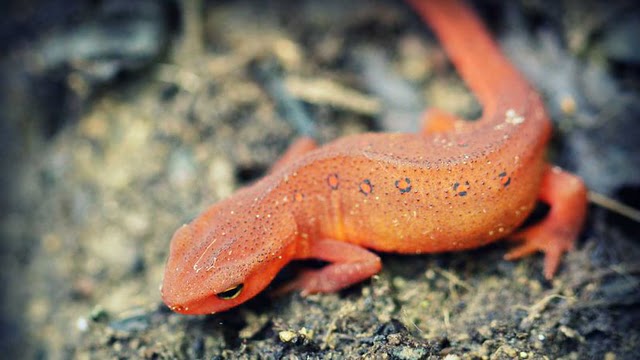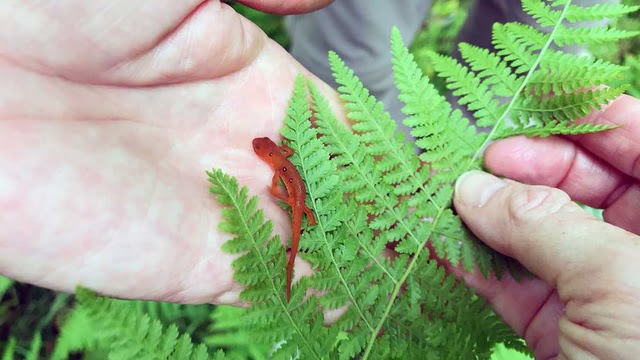Quck answer
Newts and salamanders are both types of amphibians, but there are some key differences between them. Here are the main differences:
| Newts | Salamanders |
|——-|————-|
| Have rough, bumpy skin | Have smooth, slimy skin |
| Spend most of their adult lives in water | Can live on land or in water |
| Have a more distinct “neck” between their head and body | Have a less distinct “neck” |
| Can regenerate limbs and some organs | Cannot regenerate limbs or organs |
| Lay their eggs in the water | Lay their eggs on land or in water |
Overall, newts tend to be more aquatic and have more noticeable physical characteristics, while salamanders are more adaptable and have a wider range of habitats.
Wild Animals

The eastern red-spotted newt is a member of Salamandridae, the family that includes all true salamanders and newts. julie persons photography/Getty Images
If you have ever gone hiking or backpacking in the eastern regions of the United States, you might have come across a small amphibian called Notophthalmus viridescens, or the eastern newt.
The eastern newt is tiny, measuring between 3 to 5 inches (7.6 to 12.7 centimeters) in length, and can fit on the palm of your hand.
The eastern newt begins its life as larvae that hatch from eggs in calm, fresh water. They spend most of their lives in the water until they reach adolescence, where a strange thing happens.
Between 3 and 4 weeks old, many newt larvae turn into “red efts,” a temporary phase marked by physical changes that influence behavior. These red efts have rough, orange skin and webless fingers, and they migrate to land where they hang out on forest floors or mossy meadows. As they mature, their skin moistens, their orange color fades into a dull green, and their tails become more paddle-shaped, making them perfect swimmers. They return to the water as full-grown newts ready for reproduction.
Young eastern newts can be easily mistaken for a larger, unrelated species called the red salamander (Pseudotriton ruber), which also has spots, four legs, and a long tail.
So, why do we call one animal a “newt” and the other a “salamander?” And what differentiates the two?

Eastern newts start out as larvae, and between 3 and 4 weeks old, many newt larvae turn into “red efts.”
Cyndi Monaghan/Getty Images
Life in Two Worlds
“The simple answer is that all newts are salamanders, but not all salamanders are newts,” says herpetologist and author Whit Gibbons in an email.
Salamanders are amphibians, which means that they have backbones and three-chambered hearts, just like all other amphibians, including frogs.
Other traits are skin-deep. Amphibians tend to lack scales and can breathe through several means, such as lungs, feathery gills, and through their skin. They are also ectothermic poikilotherms, meaning they can’t produce body heat internally.
The word “amphibian” comes from a Greek term that means “double life.” Most amphibians divide their lives between land and water.
While “cold-blooded” is an informal descriptor, amphibians are more accurately called “ectothermic poikilotherms.”
The word “newt” is an informal term that biologists do not use when talking among themselves.
All in the “Subfamily”
David Wake, a professor of integrative biology at the University of California, Berkeley, and the director of the AmphibiaWeb Project, a virtual amphibian database, states that the family Salamandridae includes all true salamanders and newts.
The term “newt” comes from the Middle English newte and has no scientific meaning, according to Wake. Salamanders are divided into 10 families, with the Salamandridae family being one of them. This family has subfamilies, with the largest being Pleurodelinae, which includes numerous species. Traditionally, the label “newt” is used for various salamanders in Pleurodelinae. Eurasian newts are popular in the pet trade, but North American newt species are less commonly found in pet stores. Newts tend to share certain traits, such as the development of lungs as they grow up and rougher skin than other salamanders. They also often have poison glands in their skin, with some species carrying enough toxin to kill multiple animals or humans. The Pacific newts of western North America use tetrodotoxin to repel predators, but garter snakes in the area have developed tolerance to the toxin. This has led to a game of evolutionary one-upmanship, with the newts increasing their toxicity levels to repel the snakes.
The garters that followed were even more resilient to TTX in response. People who were born during the Cold War should understand what this means. Soon, garter snakes were able to consume incredibly high amounts of TTX while facing off against absurdly toxic newts. As the toxicity grew, so did the tolerance, and this cycle continued in an ongoing biological arms race between the two species that persists to this day. It’s amazing how escalation can lead to such outcomes.
On a related note, not all newts go through the “eft” stage. According to Gibbons, “The eastern is known to do this, but not all newts exhibit this life stage and not all eastern newts become terrestrial. Some remain aquatic as adults and retain the gills characteristic of larvae… Whether the eft stage is the exception or a general rule with only a few exceptions will require more in-depth ecological research.”
FAQ
1. What is a newt?
A newt is a small, semi-aquatic amphibian that belongs to the family Salamandridae. They are typically found in freshwater habitats and have a lizard-like appearance with smooth skin and long tails.
2. What is a salamander?
A salamander is also an amphibian that belongs to the order Caudata. They have a similar appearance to newts, but are typically larger and have rougher skin.
3. How can you tell the difference between a newt and a salamander?
One way to tell the difference is by their skin texture – newts have smooth skin while salamanders have rough skin. Additionally, newts tend to be smaller and more slender than salamanders, and they often have brighter coloration.
4. Do newts and salamanders have the same habitat?
Both newts and salamanders can be found in freshwater habitats such as ponds, lakes, and streams. However, newts tend to prefer slow-moving water while salamanders can also be found in faster-moving water.
5. Can newts and salamanders interbreed?
While newts and salamanders are closely related, they are different species and cannot interbreed.
6. What do newts and salamanders eat?
Newts and salamanders are carnivorous and primarily eat insects, worms, and small invertebrates.
7. Are newts and salamanders poisonous?
Some species of newts and salamanders are poisonous, while others are not. The rough-skinned newt, for example, secretes a toxin through its skin that can be lethal to predators.
8. Do newts and salamanders hibernate?
Yes, both newts and salamanders hibernate during the winter to conserve energy. They typically burrow into the soil or hide in crevices to stay warm.
9. Can newts and salamanders regenerate body parts?
Yes, both newts and salamanders have the ability to regenerate lost body parts such as limbs and tails.
10. Are newts and salamanders kept as pets?
Yes, some species of newts and salamanders are kept as pets. However, it is important to research proper care and housing requirements before getting one as a pet.





Leave a Reply